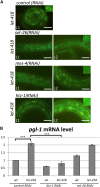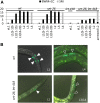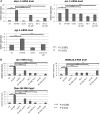A Network of Chromatin Factors Is Regulating the Transition to Postembryonic Development in Caenorhabditis elegans
- PMID: 28007841
- PMCID: PMC5295584
- DOI: 10.1534/g3.116.037747
A Network of Chromatin Factors Is Regulating the Transition to Postembryonic Development in Caenorhabditis elegans
Abstract
Mi2 proteins are evolutionarily conserved, ATP-dependent chromatin remodelers of the CHD family that play key roles in stem cell differentiation and reprogramming. In Caenorhabditis elegans, the let-418 gene encodes one of the two Mi2 homologs, which is part of at least two chromatin complexes, namely the Nucleosome Remodeling and histone Deacetylase (NuRD) complex and the MEC complex, and functions in larval development, vulval morphogenesis, lifespan regulation, and cell fate determination. To explore the mechanisms involved in the action of LET-418/Mi2, we performed a genome-wide RNA interference (RNAi) screen for suppressors of early larval arrest associated with let-418 mutations. We identified 29 suppressor genes, of which 24 encode chromatin regulators, mostly orthologs of proteins present in transcriptional activator complexes. The remaining five genes vary broadly in their predicted functions. All suppressor genes could suppress multiple aspects of the let-418 phenotype, including developmental arrest and ectopic expression of germline genes in the soma. Analysis of available transcriptomic data and quantitative PCR revealed that LET-418 and the suppressors of early larval arrest are regulating common target genes. These suppressors might represent direct competitors of LET-418 complexes for chromatin regulation of crucial genes involved in the transition to postembryonic development.
Keywords: P granules; chromatin; development; genome-wide RNAi screen; germline.
Copyright © 2017 Erdelyi et al.
Figures






Similar articles
-
Maintenance of Genome Integrity by Mi2 Homologs CHD-3 and LET-418 in Caenorhabditis elegans.Genetics. 2018 Mar;208(3):991-1007. doi: 10.1534/genetics.118.300686. Epub 2018 Jan 16. Genetics. 2018. PMID: 29339410 Free PMC article.
-
The Caenorhabditis elegans LET-418/Mi2 plays a conserved role in lifespan regulation.Aging Cell. 2013 Dec;12(6):1012-20. doi: 10.1111/acel.12129. Epub 2013 Aug 16. Aging Cell. 2013. PMID: 23815345
-
Multiple functions of PBRM-1/Polybromo- and LET-526/Osa-containing chromatin remodeling complexes in C. elegans development.Dev Biol. 2012 Jan 15;361(2):349-57. doi: 10.1016/j.ydbio.2011.10.035. Epub 2011 Nov 18. Dev Biol. 2012. PMID: 22119053
-
The NuRD complex: linking histone modification to nucleosome remodeling.Curr Top Microbiol Immunol. 2003;274:269-90. doi: 10.1007/978-3-642-55747-7_10. Curr Top Microbiol Immunol. 2003. PMID: 12596911 Review.
-
LET-23-mediated signal transduction during Caenorhabditis elegans development.Mol Reprod Dev. 1995 Dec;42(4):523-8. doi: 10.1002/mrd.1080420422. Mol Reprod Dev. 1995. PMID: 8607985 Review.
Cited by
-
Metabolic enzymes aldo-2 and pdhb-1 as potential epigenetic regulators during C. elegans embryogenesis.MicroPubl Biol. 2024 Jun 13;2024:10.17912/micropub.biology.001222. doi: 10.17912/micropub.biology.001222. eCollection 2024. MicroPubl Biol. 2024. PMID: 38947245 Free PMC article.
-
Divergent regulatory roles of NuRD chromatin remodeling complex subunits GATAD2 and CHD4 in Caenorhabditis elegans.Genetics. 2022 May 5;221(1):iyac046. doi: 10.1093/genetics/iyac046. Genetics. 2022. PMID: 35323946 Free PMC article.
-
NuRD chromatin remodeling is required to repair exogenous DSBs in the Caenorhabditis elegans germline.bioRxiv [Preprint]. 2024 Sep 15:2024.09.14.613027. doi: 10.1101/2024.09.14.613027. bioRxiv. 2024. PMID: 39314477 Free PMC article. Preprint.
-
MRG-1/MRG15 Is a Barrier for Germ Cell to Neuron Reprogramming in Caenorhabditis elegans.Genetics. 2019 Jan;211(1):121-139. doi: 10.1534/genetics.118.301674. Epub 2018 Nov 13. Genetics. 2019. PMID: 30425042 Free PMC article.
-
The zinc-finger transcription factor LSL-1 is a major regulator of the germline transcriptional program in Caenorhabditis elegans.Genetics. 2022 May 5;221(1):iyac039. doi: 10.1093/genetics/iyac039. Genetics. 2022. PMID: 35262739 Free PMC article.
References
-
- Andersen E. C., Lu X., Horvitz H. R., 2006. C. elegans ISWI and NURF301 antagonize an Rb-like pathway in the determination of multiple cell fates. Development 133: 2695–2704. - PubMed
-
- Baugh L. R., Sternberg P. W., 2006. DAF-16/FOXO regulates transcription of cki-1/Cip/Kip and repression of lin-4 during C. elegans L1 arrest. Curr. Biol. 16: 780–785. - PubMed
-
- Bender L. B., Cao R., Zhang Y., Strome S., 2004. The MES-2/MES-3/MES-6 complex and regulation of histone H3 methylation in C. elegans. Curr. Biol. 14: 1639–1643. - PubMed
Publication types
MeSH terms
Substances
Grants and funding
LinkOut - more resources
Full Text Sources
Other Literature Sources
Research Materials
